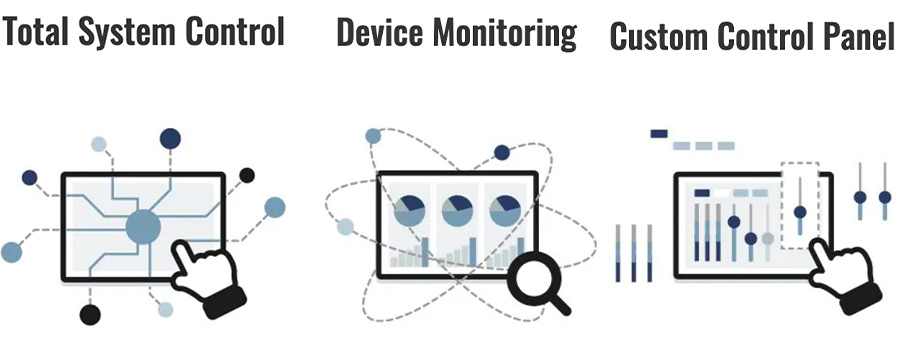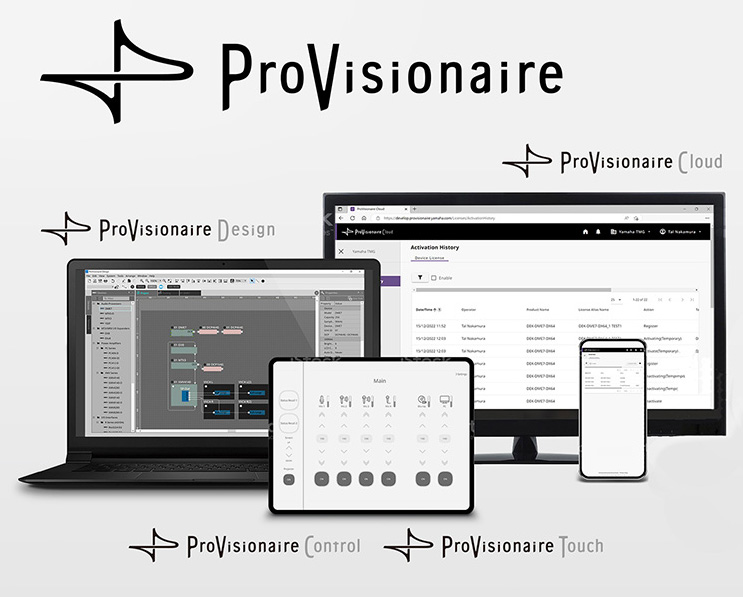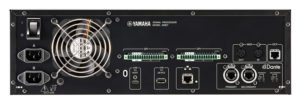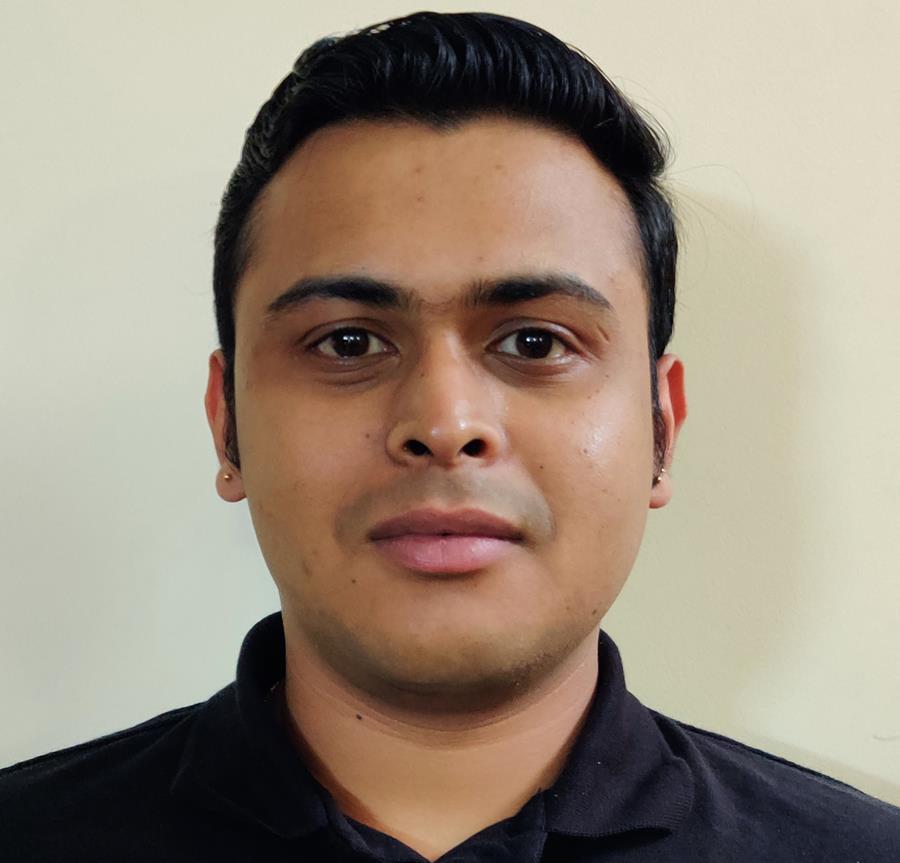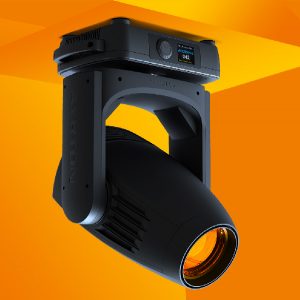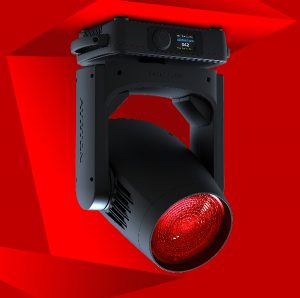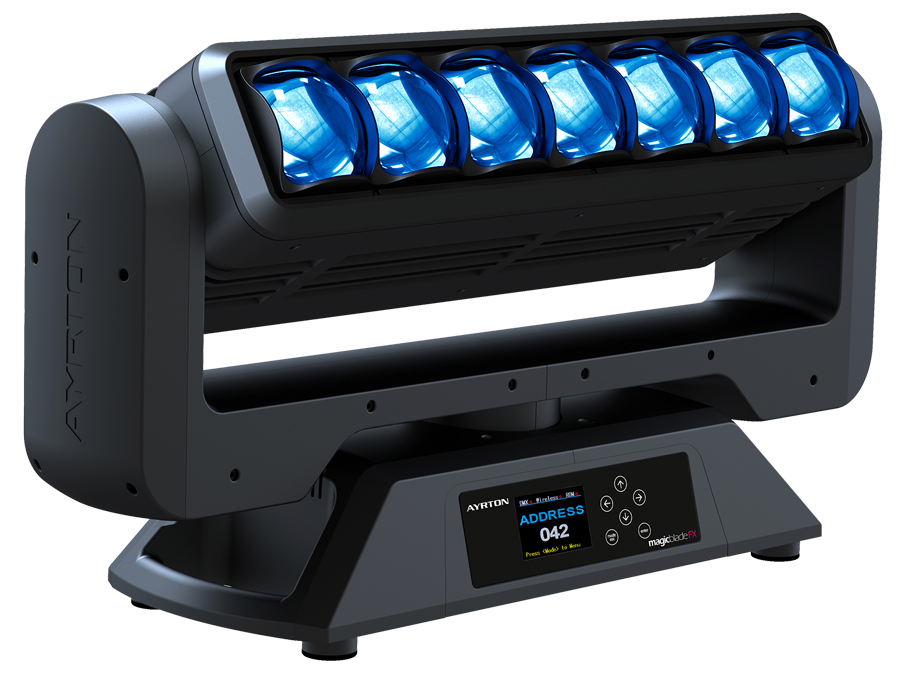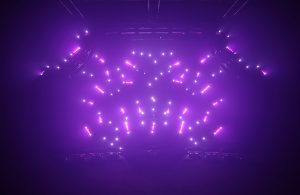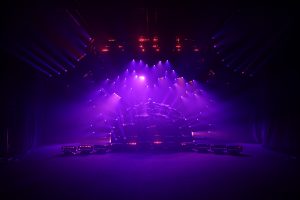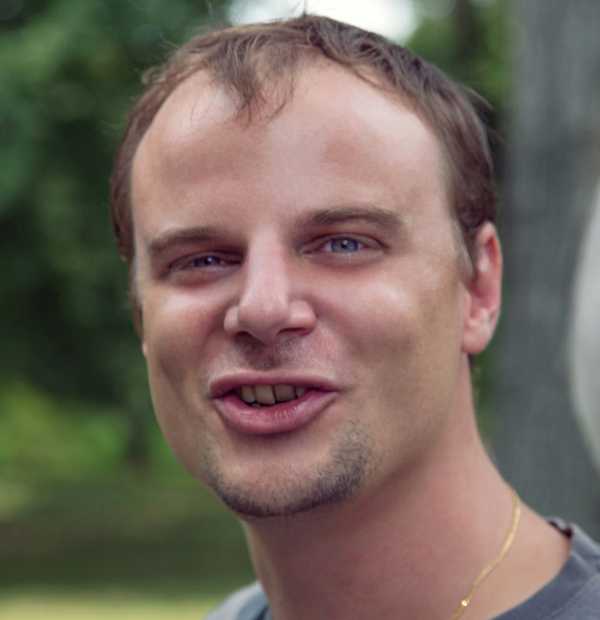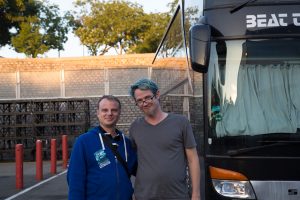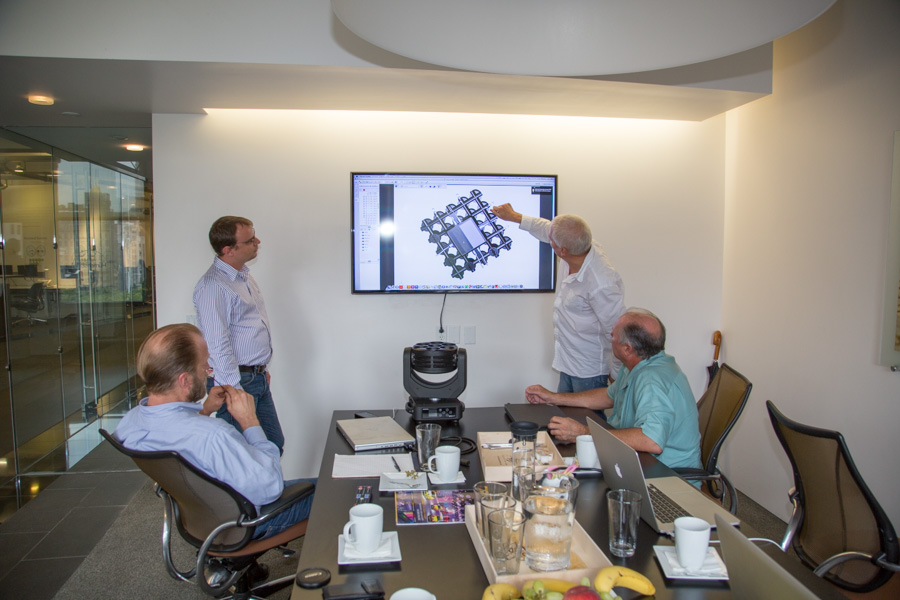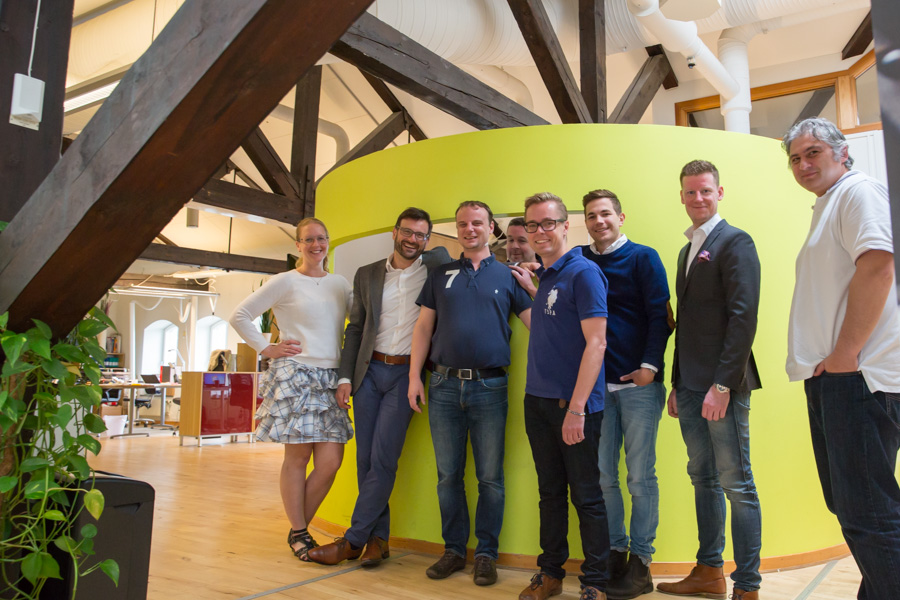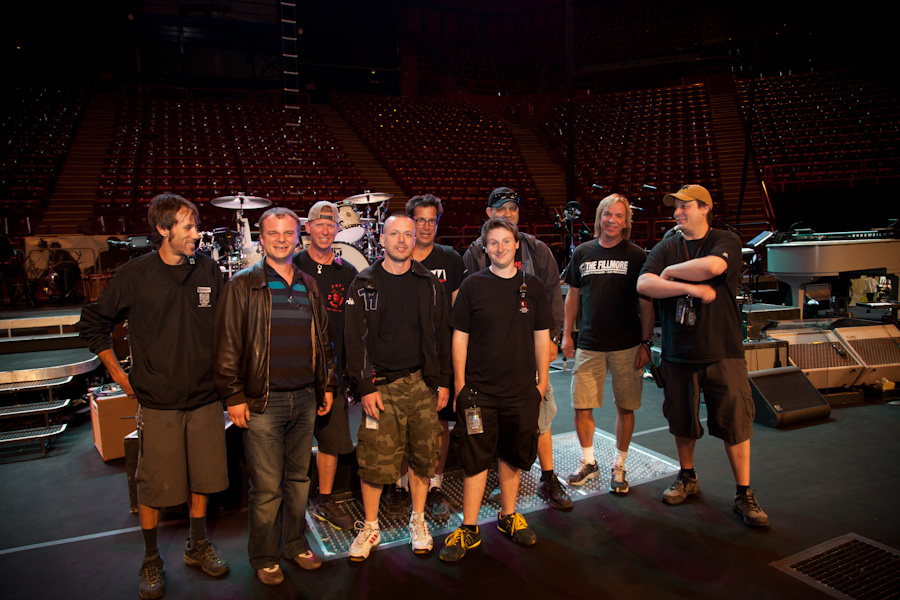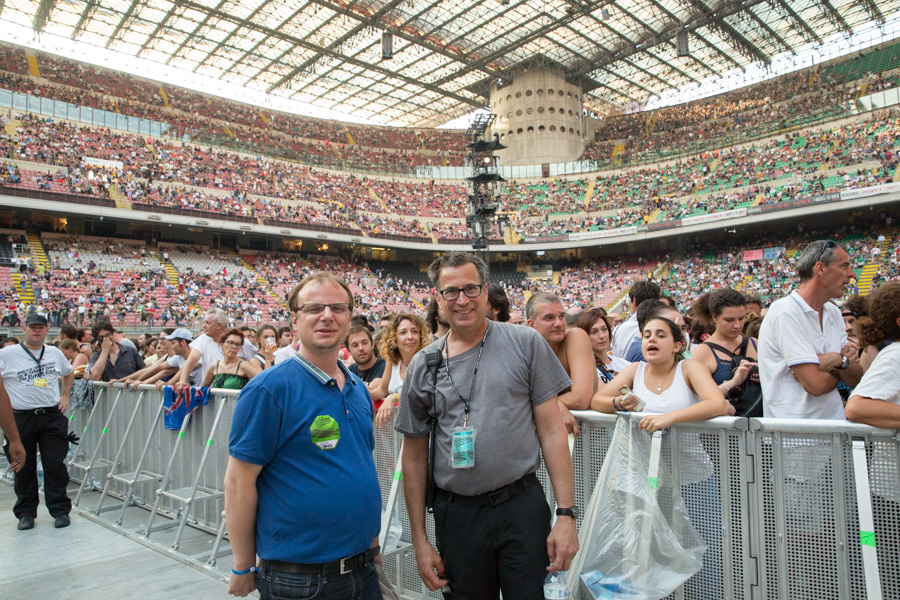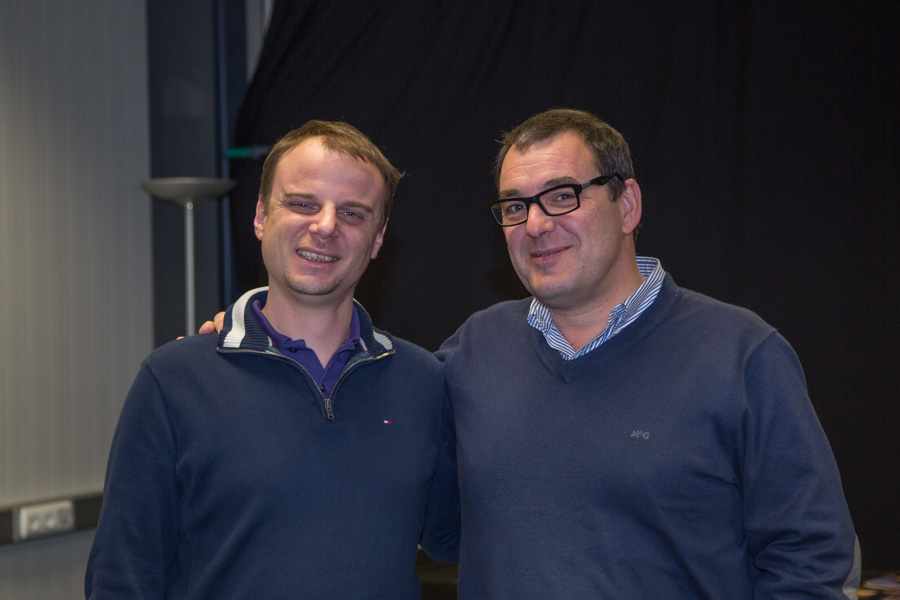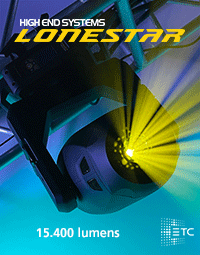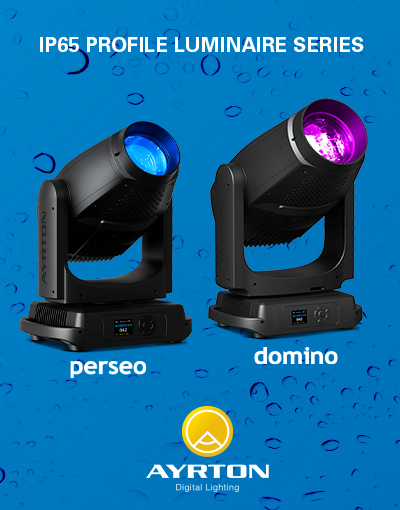As deep house and electro music producer The Avener pursues his stellar career performing at ADM concert festivals, we thought it would be worthwhile to go back and have a look at his Flash Deep Tour, from late 2015, to focus on the interactive concept developed by All Access Design (AAD). The concept is that the artist can maintain manual control over part of the lighting rig – live and in real time.

A superb display of Hardellet’s showmanship, with pixel-mapped LED emitters all following the artist via motion control (four moving triangles and the MagicBlade-R units rotating on truss totems); the vertical shapes are accentuated by light shafts projected from the Mythos units hung above the stage and the (laser-like) Sharpy beams, also mounted on the totems.
Leveraging the latest technology on the market, Alex Hardellet, lighting and video designer for The Avener, applied this interactive concept in his stage design using multiple planes with forced perspective.

It was no mean feat for AAD and Moving Load to automate the four embedded arrays of LED fixtures for both horizontal and vertical movement, with each weighing about 150 kg. The four components form the DJ cage. © Baptiste Herment
Generously mixing tungsten-based fixtures, LED luminaires and video equipment (and even some video game components), he created a rig of connected objects all under a man-machine interface to permit the show to be controlled from the stage.
In addition to selecting his music, beats-per-minute, and transitions, the DJ controlled the visual ambiance, acting as a virtual orchestra conductor of the stage design. To get the desired perspective, Hardellet and All Access Design’s engineers integrated LEDs directly in stage components made up of four triangular parts, which were fully mobile.
Any interactive and ultra high-tech design concept should include one of today’s most versatile luminaires, Ayrton’s DreamPanel™ Twin. In a matrix installation, the hybrid fixtures, moving HD video displays, backed with brilliant LED graphic beam projectors, were combined with other multifunctional fixtures like the Clay Paky Mythos, Ayrton MagicBlade™R, and other standards like Clay Paky’s Sharpy and the Martin’s Atomic 3000 strobe.
We sat down with the AAD team members and Alex Hardellet, the atypical young lighting designer who’s in charge of this wild project.
[private]

The crew from left to right: Leon Van Empel (S-Group), Alex Hardellet (Lighting Designer), Gabriel Gratineau (Video and Pixel Supervisor), Romain Villard (Moving fixture Supervisor), Charles Édouard Brun (Technical Supervisor), Samuel Chatain (Stage Manager), “Captain” (Chief Rigger) and Greg Gouraud (Moving Load – Stage Movement Creator)
SLU : The Flash Deep Tour is a collaboration of four artists. Did you do the lighting for the entire show or just for the star – The Avener?
Alex Hardellet : On this tour, AAD only handles The Avener – even though we proposed an overall killer plan that is used along with some additions for our set. We share the lighting desk with other lighting designers, which is not easy when it comes to timing. With such a huge setup for a one-shot deal, it’s hard to set aside the time for rehearsals and sound checks for everybody. So, obviously, we programmed as much as we could ahead of time.–It was really tight!
SLU : And with all that lighting gear?
Alex Hardellet : I’ve seen bigger rigs, but for us, this is a major deal having a rig like this for a DJ in France! It’s a really ambitious project, totally involving the equipment supplier (S-Group), the production company (Miala) and All Access Design.

As the four moving triangles pull away, Ayrton DreamPanel™Twin luminaires appear in the air under the Clay Paky Mythos beams in an exquisite tableau.
The magnificent Ayrton hybrids
Talk about a vendor being involved! Léon Van Empel and his company S-Group went so far as to buy the new DreamPanel™Twin fixtures especially for this tour – showing incredible confidence in the designer!

Under the overhead truss loaded with Mythos fixtures is the Ayrton DreamPanel™Twin array, flanked by the double truss totems. © Baptiste Herment
SLU : Were you able to get the production company to supply the luminaires you wanted?
Alex Hardellet : Yes, we managed to get the DreamPanel-Twin luminaires and all the LED units, as well as the Mythos fixtures and most of the other gear.
That’s mostly thanks to the equipment supplier who had no qualms about investing in the gear. They have always been very loyal to us when it comes to customized orders and integration.

The video projector right behind the DreamPanel-Twin array. © Baptiste Herment
SLU : Tell me about the Ayrton DreamPanel and MagicBlade-R luminaires. Were they an obvious choice for you?
Alex Hardellet : We fell in love – both with Ayrton products and with Yvan Péard when we saw the video demos – maybe even before that! We just had to include DreamPanel Twin to support the multi-perspective design idea. We often do front projection planes with a video projector, then we add more to create depth. But here I wanted that depth to come from far off, not from the front.
So we installed the VP upstage, behind the DJ cage, between the DreamPanel-Twin units, so that it could project volumetric light together with the DJ/LED matrix plane and the back of the Panel. Our idea was to establish the foreground and background with LEDs in the same perspective – connected through the VP’s volumetric light and obtain a mixture of several textures of light.

Pixel-mapping applied to the video projector, the LED emitters of the DJ cage, and the video display side of the DreamPanel™Twin array.
Uniform, but multiform, gear

One of the four double truss totems that Alex Hardellet added to The Avener’s set, mounted with MagicBlade™R and Clay Paky Sharpy units. © Baptiste Herment
SLU : And how are you using Ayrton MagicBlade-R luminaires in the design?
Alex Hardellet : It made great sense to use them. We were in a LED universe and I needed a fixture that could produce a lot of light and work in continuous rotation while doing LED-to-LED to extend the pixel-mapping.
The MagicBlades are really beautiful in the installation and they jump right out at you. The rest of the gear follows the same style: rectilinear, conventional and uniform.
SLU : You also have other fixtures besides LEDs… like the Clay Paky Mythos?
Alex Hardellet : I didn’t want to have too many different types of fixtures in the rig – which we wanted to keep consistent – but, that said, the Mythos can be a beam, a wash and a spot all at once!
The array of Mythos fixtures gave me a block effect that was simple, regular and very identifiable at start-up – so it had strong impact. We had to pick new and innovative fixtures to keep up with the rest of the gear, while trying to avoid having too many different units because of colour incompatibility and maintenance issues.

The Avener appears as the heroic focus of this tableau, with the three-dimensional perspective endowing him with virtual omnipotence. The video projector, DreamPanel™Twin array, and LED emitters, which illuminate the DJ cage, blend together with the video projector used principally as a backlight.
SLU : But the Martin Atomic 3000 strobes, which are all over, are not exactly something new, and the MAC Auras, to a lesser extent, aren’t either. Am I right?
Alex Hardellet : Yes, but we really have a soft spot for the Atomic. We’re fans… the sound, the power, the effectiveness. It’s hard to pass up on. It’s kind of our favourite childhood memory. The MAC Auras are used as sidelights on tripods: three on each side.
SLU : You have Sharpys on truss totems. Was that kind of a consensus?
Alex Hardellet : We use the Sharpys wherever we needed a beam effect. They are also pixel-mapped, and we enjoyed creating volumetric light from the truss totems.

The DJ impeccably presented as a musical variety artist par excellence, highlighted not only by the surrounding LED units but also by his lighting designer’s sense of drama, using Martin Mac Aura and VP fixtures to cut a silhouette of The Avener.
SLU : On the other hand, the moving components around the DJ use LEDs…
Alex Hardellet : They were custom-made for the show and the sides are motorised. It was quite a challenge trying to make these 150-kg-components move up and down and left to right. The three sections are controlled, and transverse movements were developed by our friends at Moving Load, who made it all possible on a tight deadline and budget. We were the ones who created the vertical movements with winches.

One of the four sides that form the DJ “cage”, created by All Access Design, and embedded with LEDs… © Baptiste Herment

…with moving sidelights. © Baptiste Herment
But the little something extra that really made a difference in Miala’s bid was the interactive systems and customized products that are a signature of the lighting designer.
Inspired by The Avener’s album cover, Hardellet conceived a creation that is graphic, with multiple planes of perspective, full of square elements but also very mobile and open to the audience and the artist, with the interactivity of the accessories at the disposal of the DJ.
Visually connected and immersive stage design

A god? No, The Avener making his entrance under a halo of mystical light generated from the Christie WU20K video projector used as backlight.
SLU : How do you combine light and interactivity in your stage design?
Alex Hardellet : We have a Kinect 2 for XBOX interface that can interpolate body positions and use the internal player like a mask of the person moving in real time – who in this case is The Avener. It’s managed by computers that were specially developed for the show. The idea is to mix the various perspective planes of the lighting design.
So, at the beginning of the show the VP shows the DJ in perspective under a halo like some kind of god. As he plays the game and does his show, the Kinect box follows his slightest movements perfectly. The Kinect interfaces to a computer, which sends a video signal in SDI to a PCI card in the media server. The video output can then be routed either into the VP or into the multiple DreamPanel-Twin array.

A repurposed interactive tool that The Avener uses to control the fixtures for his set: MIO wristbands… © Baptiste Herment

… Leap Motion controllers…
SLU : And you just use the Kinect to control the fixtures interactively?

…and the Kinect 2 for Xbox interface. © Baptiste Herment
Alex Hardellet : We also have Leap Motion controllers, which are sensors placed on the fingers – very precise (up to a 10th of a millimetre) – for converting the movements into signals. Then, that signal is assigned to whatever we want…
in this case, to the Ayrton MagicBlade-R fixtures to follow the movements. In fact, we repurpose all these tools used for controlling a computer without a mouse to enable the artist to act like an orchestra conductor for the automated luminaires.
It’s the same idea with the MIO wristbands that we also use for controlling light. They are a little less reliable, because they’re newer – but they have enormous potential… able to capture the positions of muscles, and therefore hand gestures in space, like making a circle move, or moving spots and triggering strobes with the simple movement of the hand.

And suddenly, everything opens up – the background, the stage – enhanced by the volumetric light of the VP as well as the Sharpys, playing their role impeccably.
Again, we’re converting information using protocols that can be processed by the lighting consoles – especially with the grandMA, which has a 3D “spacializer” to interface the MIO trackers. This can be used to set a position that is then tracked by all the fixtures in the rig. We really like this plug-and-play feature… total immersion.

The DJ booth seen from behind: mobile, embedded with LEDs, and containing The Avener’s entire workspace, turntables, touch screen for selecting songs, and the Leap Motion, Kinect and MIO interactive devices. © Baptiste Herment

The Avener’s workspace. On the left, a touch screen specially designed to communicate selected songs live to the visual designer/operator, Alex Hardellet.
SLU : So the DJ has all this equipment on him?
Alex Hardellet : Yes, he has MIO wristbands on. The Leap Motion sensors are mounted directly on his desk and the Kinect device is behind him. I keep total track of everything from the lighting console, using a monitor that watches the system so that I can intervene in case there’s a problem. The whole system runs on about 15 DMX universes, but we also have MA-Net Art-Net, OCS (Open Sound Control) and MIDI.

Protocols required? AAD has everything you’d ever need: MA-net, Art-Net MIDI, etc… © Baptiste Herment
SLU : Is your desire to constantly develop and deliver concepts for innovative, interactive or connected solutions a response to today’s lighting needs in France, or is it just because you enjoy it?
Alex Hardellet : No one ever asked us to develop this sort of concept – so we developed these interactive features, ourselves, just for the fun. I think, however, that even if all this isn’t necessarily going to contribute an astonishingly new solution in the race for higher-performance entertainment lighting, we are still meeting a technological challenge… using interactive functions that bring the audience closer to the artist – and that’s what people are really looking for. The real motivator is passion! We are all passionate about light, and when you get excited about something you want to share that feeling.

Alex Hardellet at his desk, during the show.
SLU : Of course, the artist has to play along…
Alex Hardellet : That’s key! This system requires a serious investment on the part of the user.
The Avener was immediately very receptive to the project. We didn’t have to convince him…
It’s so amazing and surreal that something like this exists – it couldn’t fail to impress – but then again, remember that interactive technology is not what makes the show. It’s just a little something extra we give The Avener and his audience: a cherry on the cake.
SLU : But you are all mainly lighting designers, right?
Alex Hardellet : To be honest, I don’t really think I’m a lighting designer at heart, not in the strict sense of the term. Still, I have a certain facility with lights and I’m able to combine them with more computer-oriented or interactive components. That doesn’t mean that the lighting gear is just an accessory. Everything we’ve developed in terms of interactive controllers, software and stage design is only there to make best use of the gear. Everything here exists for the sake of the fixtures and light!
Hardellet and his colleagues have a talent for creating technology that neither the artist nor the production staff would have ever dreamt of (or known they had a desire for).
On this one-shot tour with just a few dates, the interactive installation and multiple perspectives were a major success, becoming the hit of festivals that rarely see this sort of light and video gear.
The technical professionalism and near-perfect synchronisation – a sine qua non in electronic music – has clearly made the shows a great success.

An exquisite tableau. Regardless of all the interactive equipment, potentially omnipresent video, and technical hurdles…

…the focus of attention was on the light. How could it be any other way with such superb luminaires!

Hardellet playfully bewilders us with his vertical columns of beams and surprising perspectives. We can’t tell where the light is coming from – if it’s generated by a video, tungsten, or LED source – but we are captivated by the spacial exploration of the overall setting.
Mandatory sync as a prerequisite for going live
SLU : How urgent was synchronising part of the light playback?
Alex Hardellet : I think that when the rig starts to get big and the production and creative time window is real tight, is when you get the maximum effect. We worked a lot in previsualisation, but to cover the DJ set, you have to know ahead of time what the artist is going to play down to the BPM, and that’s tricky…
SLU : What percentage of the show would that be?
Alex Hardellet : Three songs… that’s it! The rest is live, from my console. We defined a basic set with the DJ, on which he plays his extra material live. The problem is that Tristan (The Avener) is a real DJ who prefers to mix his set live. But, even with all our modern technology, there’s no way to do synchronisation if his mix is done through USB flash drives and the BPM changes every 10 seconds!
So we had to find a compromise, using sync on the intro to his hit song – then again at the closing… to guarantee the highlights of the show work. For the rest, he gave us a big list of of songs that he might be playing, which I had to learn and code. He originally gave me about 100 – which we boiled down to about 20.

Powerful Ayrton MagicBlade-R luminaires project horizontally. While rich in video, the stage design still shows a sense of restraint and sobriety.
SLU : But during the show, how do you know which number he’s going to do?
Alex Hardellet : We created a personal control interface so that he can use a touch screen to tell me which song he’s going to play and I can lock onto it and prepare the console. And, should he forget to do that (which happens), we also developed a chat interface between his desk and my console – so we can get back on track!
With this video conference screen Alex – who is also the operator of the show – can chat live with the artist. Great idea! It’s the concept of interaction taken to the extreme: between artist and luminaires, audience and artist, and artist and lighting designer.
VLAN, dmx and video

Well-organised racks with MA Lighting Network Processing Units. © Baptiste Herment
SLU : Was the grandMA2 required to control and program the show?
Alex Hardellet : Yes, considering the scale of the system, but I’m not really married to any console in particular.
We needed to make sure that the whole system was solid – because we had a total of 120 universes with a lot of NPUs, and network output at 235 MB/sec, which is huge!
SLU : Did you also create the video media content?
Alex Hardellet : Absolutely… and we’re using it all over! In the LED array, in the DreamPanel-Twin and the VP – but, in the end, all the fixtures are only light emitters and are not necessarily equivalent to pure video when you watch the show. So I didn’t have to come up with any super fine or really narrative media content.

Hardellet favours the modernity of monochrome scenes, still adding a bizarre perspective created by the DJ cage and the Christie VP placed upstage.
SLU : Transmitting the images must really be complicated?
Alex Hardellet : We need a big interface with a lot of VLAN to dispatch all the networks over two double fibre optic cables including the backup. We have two media servers, including an Arkaos with a Mad Mapper to handle distortion, pixel mapping and interactivity. Then, a computer has been integrated in the DJ booth to send MIDI sequences over the network to sync up all the components: consoles, media servers…
Several computers are used to manage the interactive units, like the Kinect, behind the DJ. It’s true that it’s sometimes hard to mix technology and art, but since we love to develop new things, sometimes we come up with big projects, and then we have to make it all work!

Synoptic Network The Avener
The AAD cooperative has been doing exceptional work, ever since their adventure started four years ago. By pushing their projects to the limits, these young designers – lighting designers, graphic designers, developers – are once again facing a personal challenge with this concept customized for The Avener.
They succeed with total involvement, hard work, and some craziness, blazing new trails in French entertainment lighting with more interactivity and connectivity. Ayrton luminaires are amazing toys in the hands of Alex Hardellet, both the HD video panels (the front side of the DreamPanel™ Twin) and powerful volumetric light units (MagicPanel-style emitters on the back), proving that light and image can be powerfully reconciled in today’s design concepts.

We’re talking rectilinear. Ayrton LED fixtures show their best (and purest) colours – with DreamPanel™Twin and MagicBlade™R producing magnificent light bars.
Movement is equally as important as perspective in this stage design concept and, with their unlimited, continuous double rotation the DreamPanel-Twin joins in with the fluid movements of the components inside the DJ’s cage. This system was developed by AAD in collaboration with Moving Load (motion control) and S-Group (mechanical engineering and construction), proving that these creative and capable young designers know how to assemble a solid entourage. The end product is a visual experience rich in new technology and ubiquitous light.
Before you know it, movement or body sensors will enable the audience to take part in the stage design itself. Interactivity holds a lot in store for lighting. Can’t wait to see what tomorrow brings!
[/private]





